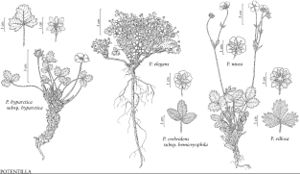Potentilla nivea
Sp. Pl. 1: 499. 1753.
Plants ± tufted. Caudex branches stout, not columnar, not sheathed with marcescent whole leaves. Stems ascending to erect, (0.3–)0.5–3(–4) dm, lengths 1.5–2.5(–4) times basal leaves. Basal leaves (1–)3–10(–15) cm; petiole (0.5–)1–6(–10) cm, long hairs usually absent, sometimes sparse to common (less so than cottony hairs), ± appressed, 1–2 mm, soft, smooth, short-crisped hairs absent or obscured, cottony hairs abundant to dense sometimes sparse with age, glands absent, sparse, or obscured; leaflets overlapping, central obovate, 0.5–2(–4) × (0.2–)0.4–1.2(–2) cm, subsessile, base cuneate, margins slightly revolute, distal ± 3/4 incised (1/4–)1/3–1/2 to midvein, teeth (2–)3–5(–6) per side, ± approximate, surfaces dissimilar, often strongly so, abaxial ± white, long hairs 0.8–1.2 mm, cottony-crisped hairs dense, adaxial usually green, sometimes grayish green, long hairs sparse to abundant, short-crisped hairs sparse to common. Cauline leaves 0–1. Inflorescences 1–5(–7)-flowered. Pedicels 1–4 cm in flower, to 5 cm in fruit. Flowers: epicalyx bractlets narrowly to broadly lanceolate or elliptic, (2–)4–7 × 0.6–1.7 mm, usually 1/4–1/2 as wide as sepals, margins flat, red glands usually absent, sometimes sparse, inconspicuous; hypanthium (2–)3–4 mm diam.; sepals (2.5–)4–8 mm, apex acute; petals (3–)4–8 × (3–)5–9 mm, slightly longer than sepals; filaments 0.9–1.2 mm, anthers 0.5 mm; carpels 20–40, apical hairs absent, styles narrowly columnar or columnar-tapered, strongly papillate-swollen at very base, rarely in proximal 1/5–1/3, 0.7–1.2 mm. Achenes 1.1–1.5 mm. 2n = 56, 63; 28, 42, 49, 70 (Asia, Europe).
Phenology: Flowering summer.
Habitat: Well-drained, exposed sites, ridge crests, coarse mineral soil, scree, usually on calcareous substrates
Elevation: 400–3800 m
Distribution

Greenland, Alta., B.C., Man., Nfld. and Labr., N.W.T., Nunavut, Que., Yukon, Alaska, Ariz., Colo., Mont., N.Mex., Utah, Wash., Wyo., Eurasia.
Discussion
Although now restricted to plants with exclusively (or at least predominantly) cottony hairs on the petioles, the name Potentilla nivea has a long history with an often wider application, sometimes including nearly all of sect. Niveae. As further confusion, J. Soják (1989) noted that the Linnaean type of P. nivea belonged to what is here treated as P. arenosa. Although historical usage of P. nivea has been re-established as a conserved name with a conserved type (B. Eriksen et al. 1999), from 1989 to 1999 the name P. nivea was applied to P. arenosa. During this period, P. prostrata subsp. floccosa was briefly adopted as the correct name for this species (for example, W. J. Cody 1996).
Molecular evidence (B. Eriksen and M. H. Töpel 2006) indicates that populations of Potentilla nivea in the Atlantic regions, including Greenland and eastern Canada, differ from those in the Beringian regions of northwestern North America, suggesting expansion from separate Pleistocene refugia. A comparable pattern was noted by R. Elven and S. G. Aiken (2007) based on morphologic characters. The conserved type of P. nivea is from northern Sweden (Eriksen et al. 1999) and belongs to the Atlantic morphologic group. The variation within each region is large, and racial recognition would accordingly be premature. Plants from sites south of the continental glaciation, which were not included in the analysis by Eriksen and Töpel, deviate in having acuminate leaflet teeth and epicalyx bractlets and in being generally more slender. Epicalyx bractlets of some Washington plants are nearly as narrow as those of P. crebridens.
Additional chromosome numbers have been reported for Potentilla nivea, but it is unknown whether these apply to this species, P. crebridens, some Asian relative, or hybrids.
Selected References
None.
